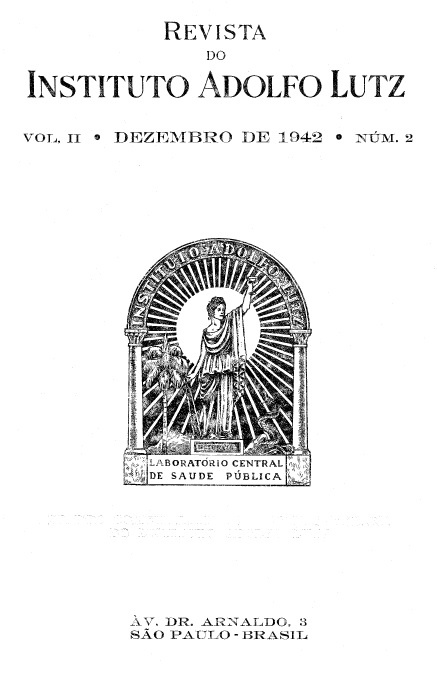Abstract
They were indetified by their morphology 1452 strains as typical Corynebacterium diphtheriae which fermented dextrose and dextrin, having this one the fermentation varying in intensity, some fermented saccharose and other starch. Those which were classified as pseudo diphteria (xerosis bacillus) did not ferment dextrin, but, fermented glucose and saccharose, The strains of pseudo diphteria, when inoculated in guinea pigs, did not kill them, having not even produced a local reaction, thus proving their avirulence. Also there have been inoculated various strains typical by their morphology to C. diphtheriae which fermented saccharose, then proving to be virulent and toxic. Strains were isolated in various cases in a same family, descending from a first case, of which a strain of C. diphtheriae had been isolated, which fermented saccharose and was virulent and toxic. All the strains as C. diphtheriae fermented glycerine with more or less intensity, while the pseudo diphteria bacillus did not ferment this carbohydrate. In 1452 strains of C. diphtheriae 184 fermented saccharose which gives a percentage of 12,6% and 32 starch or 2,2%. The strains which fermented strarch (typo gravis) rarely occurs in São Paulo, which is in accordance to our studies of the classification of types, by the morphology of the colonies. Dextrin may be considered as a basic element to the classification of the diphteria bacillus, as of the 1452 strains all have fermented it (none has failed to ferment it) , in spite of the different intensities, having behaved in the same way the strains Park 8, 3985 (Gravis), 3990 (Mitis) and 3988 (Intermedius) from the Lister Institute. The purity of the carbohydrate used is of great importance, as well as its rotatory power. These characteristics should be always mentioned in order the results may be constant. The brand of the dextrin used is important, as its power of fermentation changes with quality, according to the various authors. There was used dextrin Pfanstiehl Chemícal - Special Bacteriological (pptd from Alcohol), the rotatory power of which in a water solution in 1% [α] 19/D= 170. All these strains which were classified by theír morphology to Corynebacterium diphtheriae form acid from dextrose, maltose, d-galactose, d-levulose, d-manose, dextrin and glicerine; some strains also ferment saccharose and other starch. No acid from d-lactose, d-manitol, d-xilose, adonitol, l-arabinose, dulcitol, d-galactose , inositol, inulin, l-rhamnose (isodulcitol) rafinose, salicin, d-sorbitol, celobiose, trealose, esculin. There was used all carbohydrate from Pfantstiehl Chemical. Therefore we may separate the Corynebacterium diphtheria in 3 groups according to the fermentation: I - Fermenting dextrose and dextrin, but not saccharose; II - Fermenting dextrose, dextrin and saccharose; III - Fermenting dextrose, dextrin and starch. Alls strains were reduced nitrit, indol not formed, hydrogen sulfid was produced, varying in intensity, no gelatin liquefaction, litmus milk slightly acid. Some strains showed yellow pigment.
References
1. ANDERSON, J. S., JAPPOLD, T. C., MACLEOD,J. W. e THOMSON, J. A. - 1931 - Jour.Path. & Bact. 342, 667.
2. ANDREWS, F. W., BULLOCH, W., DOUGLAs, S. R., DREYER, J., GARDNER, A. D., FILDES, P., LEDINGHAM, J. C. G. e WOLF, C. G. L. - 1923 - Diphtheria Its bacteriology, pathology and immunology. Ris Majesty"s Stationer Office, London,
3. BARRAT, M. M. - 1924 - 1925 - Jour. Hyg., 23: 241.
4. BERGEY - 1939 - Manual of Determinative Bacter lology, 5th. edition.
5. DURAND,P. - 1920 - Compt. Rendus, Soc. Biol., 83: 613.
6. FROBISHER, M., Jr., - 1938 - The Amer. Jour. Hyg., 28: 1.
7. HAMILTON, A. e RORTON, J. - 1906 - The Jour, Inf. Dis., 128.
8. KNAPP, A. - 1904 - Jour, Med. Res., 12: 475.
9. LEHMAN-NEUMANN - 1896 - Phililert, Manual of Bacteriology.
10. LEHMAN-NEUMANN - 1927 - Bakteriologische Diagnostik, 7 Auflage, II Band.
11. MORSE, M. E. ~ 1912 - Jour. Inf. Dis.,11: 253.
12. MENTON, J. - 1923 - Jour. Path. Baet., 35: 651.
13. MORSE, M. - 1912 - Jour, Inf. Dis., 11: 253.
14. PARK WILUAMS, e MANN - 1922 - Jour, Imtmm., 7: 243.
15. PERRY, WHITLEY, e BETRAN, E. - 1936 - The Am,. Jour, of Hyg., 23: 581.
16. PESTANA, B. R., AMARAL, J. P. e BARRETONETO - 1939 - Memórias do Inst. Butantan, 13: Medical Research Council - 1930 - A System of Bacteriology in relation to Medicine, vol. V.
17. TOPLEY e WILSON - 1936 - The Pr inciples of Bacteriology and Immuníty - 2.a 'ed., Baltímore,
18. ZINSSER, R. - 1907-1908 - Jour. Med; Res., 17: 89.

This work is licensed under a Creative Commons Attribution 4.0 International License.
Copyright (c) 1943 Instituto Adolfo Lutz Journal
